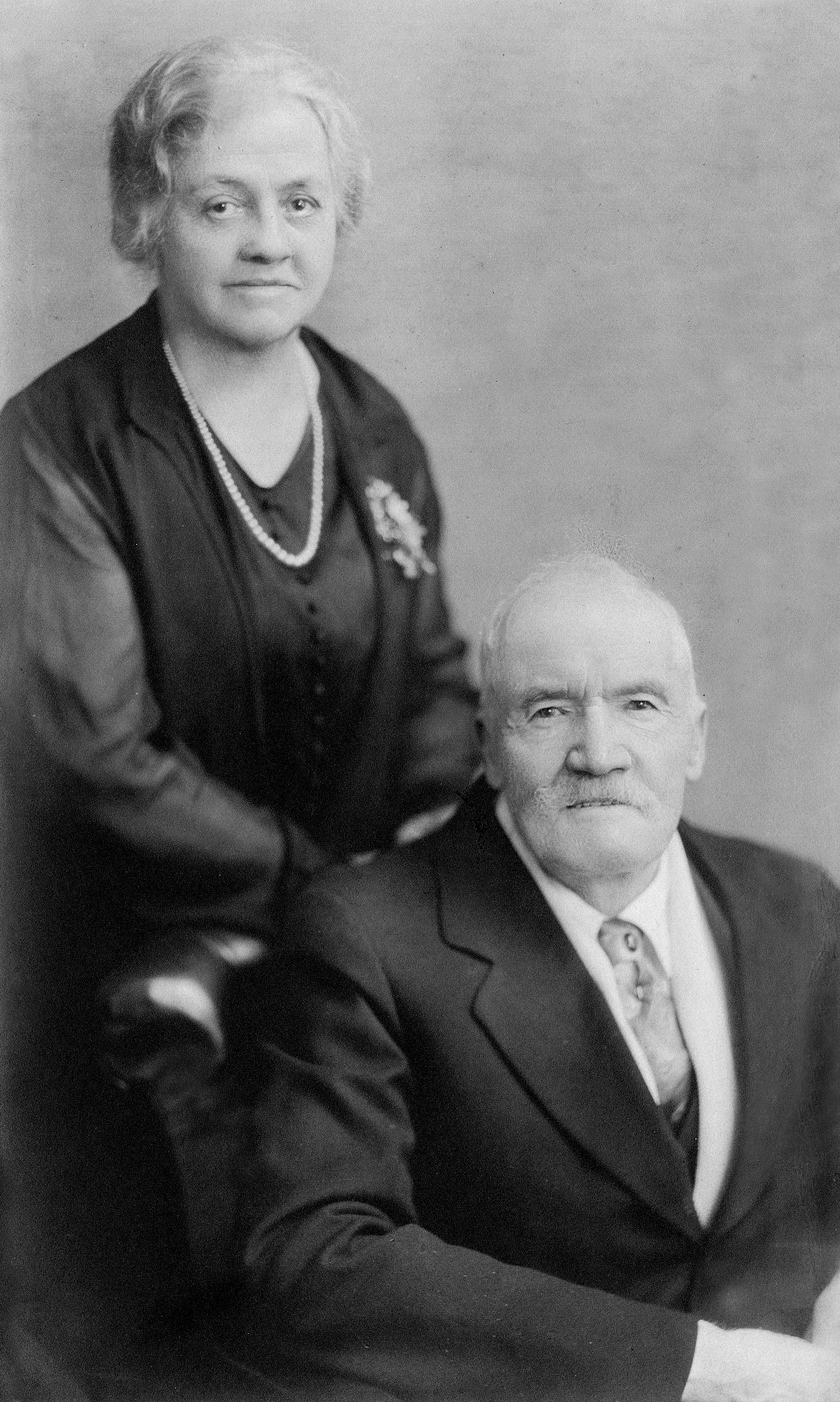(Contributed by the Thomas Tolman Family Organization. Excerpt from Judson Tolman: Pioneer, Lumberman, Patriarch by E. Dennis Tolman, Second Edition, 2004, pages 103-105).
John Albert was born September 15, 1855 in Tooele, Utah third son and fifth child of Cyrus and Alice Bracken Tolman. John grew up in Tooele. He met and married Emmeline Jordon in 1878. They homesteaded in Idaho with John’s parents and other family members for over ten years.
Five children were born to John and Emmeline in Marion, Idaho: Albert Raymond (1879), Leo Grant (1884), James Frances (1887), Alfretta (1889), and Sherman (November 10, 1891). Sherman was nine months of age when John and Emmeline emigrated to Alberta, Canada with their young family in 1892. They left a large, comfortable brick home at Marion and traveled by covered wagon to this new land. During their journey which lasted about two months, they drove a pair of mules and a team of horses, and brought all the rest of their livestock along with them.
They settled near Cochrane for two years, then the entire family moved to Lacombe. There both John and his son Ray filed on homesteads. Four more children were born while they lived at Lacombe: Minnie (1895), Carl (May 7, 1897), Oliver (1899), and Emma (1903).
The family lived in a log shack for two years, then built a home from spruce, logged from a grove nearby and planed at a saw mill near Lacombe. The children attended school in a log building for a few years until the Central School was built three miles east of Lacombe which provided an education up to grade eight.
In 1900, John, a Mr. Burrows, and a Mr. Uquahart formed the Crooked Lake Ranching Company. The Company ran about 1,000 head of cattle marked with the 6UN brand on the right rib. John’s personal brand was TOL. There was open range to within fifteen miles of Lacombe. John’s family brought lumber from Lacombe and built a house where the town of Rumsey now stands. This house was used as a ‘line shack’ when the boys of the family were out caring for the range cattle. Their nearest neighbor was an Englishman, called Mr. Mottes, who lived in a log shack in the coulee. The only other neighbor at this time was a Scotsman. Mr. Calhoun, who lived in the Hand Hills. About this time John’s brother, William Augustus Tolman built a ‘line shack’ in the Moore coulee and ran range cattle in this area. In 1903 the Ranching Company fenced a Township of land, that ran from the McCall coulee east to Engel Lake, making a semi-circle that ended at the Moore coulee. Engel Lake was known at the time as “Drowning Lake,” as 20 head of stock had fallen through the ice and drowned during the winter of 1903.
In 1904 the Government surveyed this part of the province, and although the Crocked Lake Ranching Company applied for a lease to the area enclosed by the ‘Big Fence’ (as it was called) the lease was not granted.
In the spring of 1905 the House was moved from the Rumsey site to the coulee near the Red Dear River. The present road is built in this coulee and parts of the foundations of the farm buildings can still be observed on the north bank.
In 1906 this part of Alberta was thrown open to homesteaders, and the Crooked Lake Ranching Company was dissolved. During the summer a prairie fire burned all the grass land, the only available pasture for approximately 200 head of stock was in the river banks. All the hay possible was cut and stacked off the flats bordering both sides of the river as far north as Wooden’s Mine. In all, about 200 tons of hay were stacked for winter use. In the fall, John broke his leg when the “democrat” in which he was riding hit a culvert on a high narrow grade. It tipped over catching his leg in the spokes of the wheel. He was unable to travel or help with the cattle out on the range, so Frank and Sherman spent the winter of 1906 alone at the head of the coulee. They had started to uncover a seam of coal, but snow began to fall on November 10th and operations came to a standstill before they had managed to mine any. A very hard winter was ahead of them.
Toward the latter part of February there was a slight warming trend and Ray rode out from Lacombe making the trip in five days. Sherman was relieved of his cow punching duties, so he started home to Lacombe early the next morning. He arrived at the usual stopping place in good time, and decided to go on to the next over-night stop, which was about 10 miles away. When he arrived at the second stop it was still daylight. He was anxious to get home, so he decided to push on to Ewing, even though it was 10 miles further on. He managed to follow cattle trails and sleigh trails for some distance, but finally he ran out of trails altogether. It began to snow heavily and night arrived, seeming quicker than usual. Sherman knew he was at least six or seven miles from Ewing, but in the darkness without a trail to follow, he was unable to guide his horse. His horse, Ramsay, had made this trip a few times before. Finally Sherman dismounted, and grasping his horse’s tail was led safely into Ewing, arriving at two in the morning. He made the trip home to Lacombe in three days. By the time spring arrived 50 head of stock had died of starvation.
John filed on a new homestead, on which Sherman and his son, Robert, and families later dwelled. John moved his family from Lacombe to the head of the coulee in the summer of 1907 and erected the rest of the farm buildings.
The first ferry went into the water in the year 1907. In the year 1908 the Trochu Valley put a branch store near. The Tolman Post Office was opened the same year. John’s daughter, Alfretta handled the mail and took care of the store. Mail and supplies were delivered from Trochu. When the ferry was unable to operate, supplies were delivered by a carrier fastened to the ferry cables, with pulleys being used to move it across.
In 1911, John bought script land, that had been issued to veterans of the South African War. A new home was built on this half section of land, and the family moved to this new site. Alfretta was married from this home in the fall of 1911, to Mr. Oatis Thompson. John was one of the first counselors of this municipality and Ray Tolman the first Justice of the Peace.
Blanche Greening was the first qualified teacher in the Rumsey school. She boarded with the Tolman family, east of Rumsey and drove a buggy to and from school. The one room school she taught in, has since been renovated to make the Rumsey United Church. Sherman Tolman and Blanche Greening were married at Horn Hill, on July 14th, 1913. They bought the homestead from Sherman’s father and lived the first year of their married lives at the head of the coulee. The next summer they moved the old store and post-office down to their next home.
These buildings form part of their home. Blanche and Sherman raised four children: Sherman Lloyd, Leslie, Robert Greening, and Colleen. In 1934 they built an additional wing onto their home from logs cut in the coulee beside the house. The old house, at the head of the coulee was pulled down, and a garage was built from this lumber. This structure then formed the main part of the Robert Tolman home.
Blanche and Sherman survived the dirty thirties, along with many of their friends. One year they re-seeded their crop three times and still did not harvest a bushel of grain. They did their farming with both mules and horses. Sherman had the first tiller in the district, pulled by four mules and four horses. He bought his first tractor in 1941, from Mr. Dave Shepherd. It was an old Hart Parr, that sounded and often acted like the instrument of the devil. In 1944 he bought a brand new John Deere.
Their first radio was acquired in 1924. It ran on dry batteries and was equipped with car phones.
Many of the family members served their country in both world wars. At one time, Ray, Lee, Frank, Fretta and Sherman, as well as many of their children were farming or making their living in this district. Over the years, most of them have moved on to other occupations. Clarence Tolman, (Ray’s son) and Mr. and Mrs. Sherman Tolman, Bob and Alma Tolman and their three children: Elizabeth, Lorraine and Robert, who farmed, remained in the area.
John and Emmeline retired to the coast in 1916, where they lived to enjoy their 67th Wedding Anniversary. John died May 31, 1946 in Vancouver, British Columbia, Canada at the age of 94 years. Emmeline, was hospitalized the last four years of her life, with a broken hip. She lived to the age of 95 and died in 1952 in Vancouver, British Columbia, where she and John were buried.


